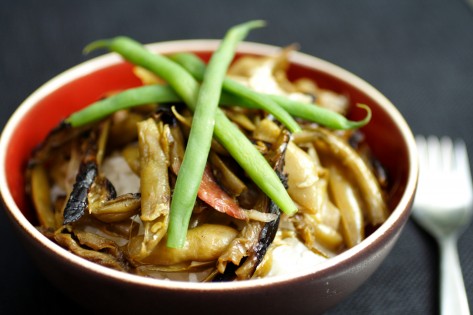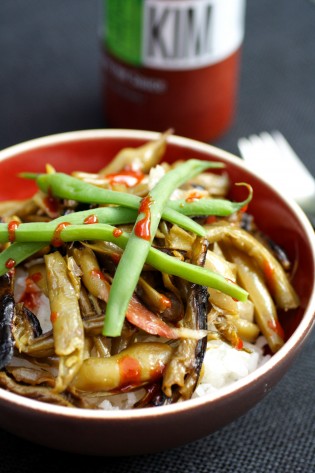Bean Cuit

I wrote this post more than a month ago, when green beans were still plentiful. Then, before I had a chance to put the finishing touches on it, I got a story assignment, my first since moving to Richmond. (It’ll be published in the November/December issue of Edible Richmond Magazine). Of course I fell into that deep hole of writin’ and researchin’, like I always do when I get a chance to have a byline, so Bean Cuit had to wait. Hope there’s still lovely fresh green beans about somewhere. Considering how this method has you cook green beans to smithereens, I would think that a frozen stash of summer’s abundance will work just as well.
* * * * * * * * * * * * * * * * * * * * * * * * * * * * *
I may end up being one of those old people that you can’t let in a kitchen anymore because they’ll leave the stove on and burn the whole friggin house down. It’s going to suck to not be able to cook.
Several weeks ago I made a pot of slow simmered beans and peas: a couple of handfuls of pole beans from our 12-foot-tall Turkey Craw pole bean plant in our courtyard, the remaining bush beans from the plant in our community garden plot, and some shelled pink-eyed peas, also from our garden plot, added sequentially in descending order of size to a pot of water seasoned with a healthy teaspoonful of sea salt and even healthier spoonful of bacon grease. When the beans had become withered and dull in color and velvety soft, and when the water had transformed into nutritious pot liquor, I turned off the heat and went for a walk.
Upon returning, I thought I heard my husband in the shower, but at that moment I realized the sound I was hearing was the sound of the last amount of pot liquor evaporating into the air and sound of beans sizzling on the bottom of a dry pan. Shit! I hadn’t turned off the heat. I ran to the kitchen and the beans—at least the beans that were at the bottom of the pan—were, quite simply, burnt. My old me would have thrown out the beans. Instead, I tasted one, and it was delicious.
Sort of like the burnt ends in barbecue, the burnt beans and peas were full of condensed flavor and were pleasantly bitter and sharp and caramelized and sweet and salty all at once, and they added a really great contrast in texture to the beans on top that didn’t get burnt: think green bean casserole topped with fried onion rings (another mid-century recipe we owe to Campbell’s Cream of Mushroom Soup) or the fried onions that top rice and lentils in a Middle Eastern dish called Mujaddara (which predates the casserole by 729 years).
Because the beans were so pungent, nearly like a vegetal condiment, I decided to eat them atop a bowl of steamed short-grain rice with some hot sauce. I’ve been eating a locally made, Korean-based hot sauce called KimKim of late, and it was perfect.
More recently I tried to replicate my bien cuit’ed beans to see if I could turn my accident into some sort of conscious cooking method, so that you might get the same results in your home.
Second time around, I think I was even more successful. Apparently editing recipes in my office upstairs—sufficiently far from the smells and sounds of food cooking (or burning) in the kitchen—did the trick. Lost in the process of editing a recipe called Eggs in Purgatory, I complete forgot about my Bean Cuit. Happy accident, again.
The recipe:
The second time I made my burnt beans, I used mostly green beans (purchased from Pole Bean Produce) and a couple of handfuls of pole beans from my pole bean plant, but of course you can use any type of fresh bean that you like. They cook down quite a bit, so I recommend making a large batch.
- Any mixture of fresh beans (pole and/or bush), tops removed (and strings, too, if using pole beans)
- Shelled fresh cow peas, if desired (use smaller quantity than beans)
- A couple of bacon slices or a spoonful of bacon fat
- Sea salt
- The ability to be distracted, lost in thought, or forgetful
For serving:
- Steamed short-grain rice
- Hot sauce of choice (try KimKim Sauce)
Search out the most slender and tender of the green beans and set aside.
Place the beans in a large pot that preferably is wider than it is tall and cover with water by about 1 inch. Add the bacon and a couple generous pinches or salt. Cook over medium heat with the lid ajar. If the beans are not uniform in width, start with the largest beans and add the rest every 5 minutes or so, sequentially in diminishing size. Add the shelled cow peas, if using, when the beans have dulled in color. When all the beans are a dull color and limp and the peas are tender, about 1 hour, remove the lid and continue simmering until all of the water has evaporated and the beans/peas are beginning to burn on the bottom layer, about 1¼ hours.
Bring a small pot of salted water to a boil. Add the reversed slender green beans and cook until tender but firm, 4 to 5 minutes, depending on their size. Drain.
Serve the bean cuit over rice topped with the bright green slender beans and hot sauce.

Bean Cuit with KimKim Sauce

My bien cuit’d pan. It took a bit of effort to clean, but I did restore it to its former self. Heavier bottomed pots clean up easier.
